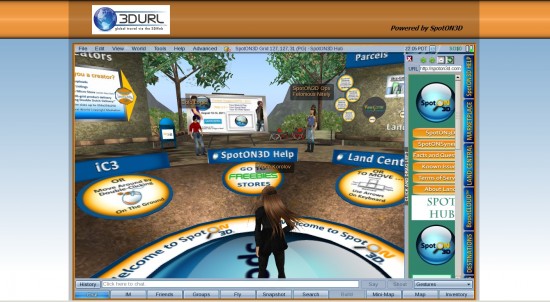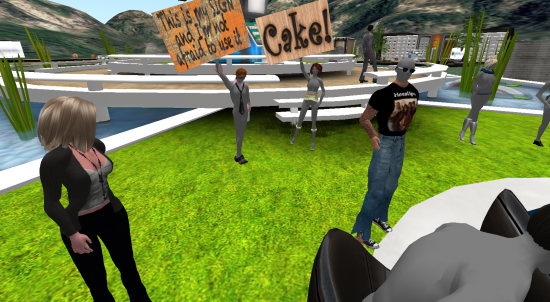SpotON3D is a small commercial grid, with more money and programmers than customers.
It has developed three innovative pieces of technology, two of which nobody cares anything about, and one, a browser-based viewer plugin, that got people all excited. Including me. It’s a great little piece of functionality, and an elegant solution to a problem people have long had with Second Life and OpenSim.

It lets people log into an OpenSim grid without leaving the browser.
That’s it. It doesn’t instantly make OpenSim perfect, and something better is likely to come along in a year or less, but, right now, its the first usable tool of its kind. It even works inside Facebook pages and lets folks log in with their Facebook accounts, if they’d like.
Finally, after years of plugging away in obscurity, SpotON3D had something that people actually wanted.
But, instead of parades in their honor, they got called names, threatened with boycotts and picketed by protesters holding nasty signs — like “meh” and “Cake!”
And no, it wasn’t because people were jealous of their success. In fact, the strongest criticisms came from owners of grids that were much larger than SpotON3D. Really, there’s been no success so far to be jealous of.
And it wasn’t just the fact that SpotON3D filed a patent on OpenSim-related technology. Other companies in the OpenSim space had filed patents before — ReactionGrid for a process for deploying and managing OpenSim and  IBM for virtual world design methodologies — and open source advocates were outraged.
There were no calls to boycott ReactionGrid or IBM, however.
Part of the reason? Bad, bad, bad public relations moves on the part of SpotON3D. (Okay, maybe there were other reasons, too. But bad PR certainly didn’t help.)
The sad thing is, they seemed to be really trying. They commented on blogs that discussed the patent issue. They held two public forums — one on their own grid, and one in Second Life — and top executives showed up and answered questions at each event. But it just made things worse.

Here are five big PR rules that they broke:
1. Know your audience
SpotON3D may plan to attract the general public to their grid with their new plugin but let’s be realistic — folks will still have to use that damn Second Life-derived viewer. The plugin just wraps it up and sticks it in a webpage — it doesn’t change the actual interface.
As a result, their early customers will probably be people already in OpenSim who will now be able to bring in their friends and relatives a little easier.
But OpenSim users are a special bunch. The early adopters in particular are big supporters of open source software and open standards. Most have a live-and-let-live attitude towards proprietary, closed software — what other people do on their own computers is their own business. But when vendors seem to threaten the values they hold sacred, they get upset.
IBM and ReactionGrid had, to some extent, inoculated themselves by demonstrating that they shared the values of the OpenSim community. They donated code. In IBM’s case, a great deal of code. They both embraced the hypergrid, a technology that allows avatars to travel from grid to grid. Most recently, ReactionGrid has donated a full set of starter avatars in the form of a Community Commons-licensed OAR file. That was a nice gesture, and much appreciated by folks starting up their own mini-grids.
Now there’s nothing wrong with keeping a grid closed and off the hypergrid. Several successful commercial grids, like InWorldz and Avination, do just that.
But by not making any effort to demonstrate that they share the values of the broader OpenSim community — and threatening to sue companies that infringe on their patent, if it is granted — SpotON3D set themselves up in direct opposition to that community.
2. Be willing to compromise
After ReactionGrid’s patent application drew concern from the community, ReactionGrid listened to those concerns — and said they would actually amend their patent submission so that it would be limited to not just a particular business process, but the particular business process specifically using ReactionGrid’s software. And they provided details about just what that was.
“This patent will not limit anyone in the virtual world community from doing anything whatsoever that isn’t related specifically to our unique R.O.A.R. software and how we use it to build our business,” said ReactionGrid CEO Kyle Gomboy in a comment on the company blog.
In other words, ReactionGrid won’t be going after OpenSim groups and companies that independently develop similar technology.
Critics commented that ReactionGrid responded “sensibly and fairly.”
Compare that with SpotON3D’s response:
“I’m not going to let the community stomp all over us,”  said SpotON3D cofounder and CEO Stevan Lieberman, who is also an intellectual property attorney with Greenberg & Lieberman, in a SpotON3D-sponsored discussion forum Friday. “If they  try to use technology that we have obtained patents on, then we’ll make a decision on what happens.”
Lieberman also refused to provide any details about the specifics of the patent.
“It would be to the disadvantage of SpotON3D to release that… for some reasons I’d rather not say,” he said.
3. Be willing to admit mistakes
This was Gomboy’s response to a question about the details of the ReactionGrid patent application:
“Insofar as publishing a post about a patent without the details — Â I agree, big mistake on my part,” he wrote. “Lesson learned. I did not think that aspect through because in my head the patent wasn’t going to affect others. I know better now.”
Very classy.
Meanwhile, here’s Lieberman’s response to critics:
“I haven’t appreciated being fired at to such a degree by a community I thought I was a part of,” he said. “The people who did that should be ashamed of themselves.”
Instead of admitting mistakes, the company has doubled down, instead. Its viewer plugin has been revamped so that it now can only be used to access the SpotON3D grid — the grid manager option has been removed from the login screen.
However, company co-founder and COO Tessa Kinney-Johnson denied that the multi-grid login option was removed, and said that the company has only shut down the Facebook access page, temporarily. The mistake is surprising, since she said at a previous forum that this “exploit” would be removed. But maybe she honestly didn’t know — it’s something that’s easy enough to check, so not really any point to lying about it.
4. Don’t play the victim card
During today’s event and SpotON3D’s previous attempt at talking to the community about the issue, Kinney-Johnson repeatedly tried to portray her company as a victim.
Despite the fact that SpotON3D is better funded than just about any other OpenSim startup out there, and with more paid staff than probably all of them put together — 12 paid programmers alone — Kinney-Johnson has repeatedly tried to convince the public that everybody else is allied against her. Unfairly, of course.
Like when she tried to tell an OpenSim developer about a security bug — and they tried to charge her $600 to fix it. Or someone accused her of whoring herself out to get business.
Yes, bad things happen to people. But these things aren’t relevant. Remember when BP CEO Tony Hayward complained that he’d like his life back — after his company spilled 4.9 million barrels of oil into the Gulf of Mexico? Oh, poor, poor Tony Hayward. How the media was hounding him! Well, he got his life back all right — he got fired — after a brief detour to Siberia. And not the metaphorical one. The actual Siberia.
“We are human beings,” said Kinney-Johnson. “We have emotions and motivations.”
That doesn’t fly.
On the one hand, SpotON3D’s patent — if broad enough, and granted soon enough — could significantly hurt other OpenSim companies and interfere with the development of OpenSim. Â On the other hand, SpotON3D’s feelings are hurt because people are upset.
Really?
5. Use repetition to help your cause, not hurt it
Every politician and company executive knows you come to a public event with a list of talking points, and you repeat those talking points every chance you get.
It takes practice to stick to your script, especially when you get caught up in the emotion of the moment. That’s where public speaking lessons and media training can come in handy.
But sticking to your points can cause you harm if those points are what made everyone mad at you in the first place.
Say, for example, the community is upset because a company, oh, says its trying to patent something but won’t say exactly what it is.
Repeating, over and over again, in different forums, that SpotON3D isn’t going to provide more information doesn’t help — that’s what made people upset in the first place.
And it makes it harder for them to swallow the positive messages, like SpotON3D’s repeated claims that its actions will benefit the broader OpenSim community.
Some hints for getting out of this PR mess
It’s easy enough to criticize. But how about some constructive solutions?
Well, as it happens, I’ve got a few ideas…
- Donate something. If OpenSim server license issues are currently a problem, donate to the viewer side. Or donate stand-alone modules. Or avatar starter packs, like ReactionGrid did. Or a collection of Creative Commons-licensed plants. Roses are always nice. SpotON3D’s business model is built on work donated by the open source community. It wouldn’t kill them to give a little back.
- Or just donate money. OSGrid is a non-profit — they always need cash to run their servers and do all the testing they do on OpenSim code. Every bug they find and fix is another bug that won’t plague SpotON3D’s users. It’s a good deal.
- Or land. Non-profits can always use some free space for meetings, classes, museums — all that feel-good stuff that they do. And their projects always bring in positive publicity, as well.
- Or access to the viewer plugin. Folks running teeny-tiny little mini-grids on shoestring budgets aren’t SpotON3D’s target customers, anyway. Give them a free viewer plugin, so they can make it easier for their friends or colleagues to access their grids. When they grow bigger, they’ll start looking around for real hosting, and if SpotON3D was nice to them while they were small, they might decide that it’s a nice company to do business with when they’re bigger.
- Or just rethink those patents. Make the focus of the patent narrow enough that it won’t affect other OpenSim-based companies. Or pledge to use patents only defensively, not offensively, and join other OpenSim-based companies in creating an organization that would protect the community against real patent trolls. Or just ditch the patents altogether — many companies are opting to keep their code secret, and just license it, instead.
- Kitely Mega Worlds on sale for $90 per month - July 19, 2024
- OpenSim regions up, actives down with summer heat - July 15, 2024
- People think AIs are conscious. What could this mean for bots in OpenSim? - July 12, 2024
